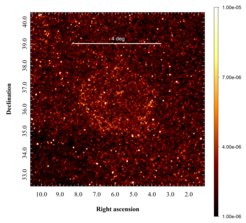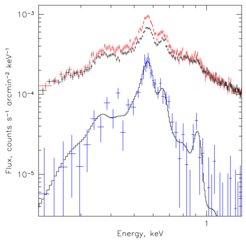Newly discovered supernova remnant as a probe of the hot gas in the Milky Way halo

Supernova remnants (SNR) are extremely interesting objects that arise after a supernova explosion, when the expanding envelope of material that is ejected by the exploding star interacts with the surrounding gas. Astronomers have identified several hundred SNRs in our Galaxy, with ages varying from hundreds of years (e.g. Kepler's supernova) to several tens of thousands of years. The remnants are often circular or ring-shaped as the gas is being compressed by the shock wave. The SRG/eROSITA X-ray sky survey has now found another SNR (Fig. 1); however, several factors suggest that the new object might be unusual.
First of all, the location of high above the Galactic plane indicates that the supernova is plausibly a thermonuclear explosion of a white dwarf. While most supernovae are associated with the collapse of a massive star, these are mainly observed close to the galactic plane. In contrast, thermonuclear supernovae (the so-called Type Ia supernovae) are associated with low-mass stars and can be found outside the disk, e.g. in the “halo” of the Milky Way.
The X-ray spectrum of G116.6-26.1 (Fig. 2) provides yet another important piece of information. It comes from the gas compressed by a shock wave but contains the same set of lines of hydrogen and helium-like oxygen ions as the diffuse emission from the hot gas in the Milky Way halo. Such ions are typical for gas with a temperature of 1-2 million degrees. Why is there the same set of ions in the halo and in the newly found object? Is it just a coincidence of the gas temperatures? While this is possible, there could be another explanation:

The supernova could have exploded in the halo gas itself. As the density of the halo gas is very low, the time for the change in the ionization balance is longer than the age of the supernova. This means that even after the gas is compressed and heated by the shock wave, lines characteristic of the gas temperature in the halo will be observed. In other words, the gas “remembers” its initial temperature even after being compressed by the shock wave.
The same assumption implies that the supernova remnant becomes a source of bright X-ray emission in the lines of oxygen ions since hotter electrons can now more easily excite the energy levels of the ions. That is exactly the reason why it was actually possible to find this SNR, otherwise it would have been much too faint to be seen in X-rays. In this model, a supernova exploded in the galaxy's halo about 40,000 years ago, and now the remnant has a gigantic physical size of about 600-700 light-years in diameter.
This means that we can use such supernova remnants to probe the hot gas in the halo of our Galaxy. What remains to be done is to find a few more, similar objects. The SRG observatory will do five more surveys in the coming years. The astronomers hope that by the end of the last survey, the list of supernova remnants will contain many new and interesting sources.
The Spektrum-Roentgen-Gamma (SRG) Observatory
The SRG spacecraft was designed by Lavochkin Association, Roskosmos corporation and launched on July 13, 2019 with a Proton rocket from the Baikonur cosmodrome. The SRG observatory was built with participation of DLR, Germany, in the framework of the Russian Federal Space Program by the initiative of the Russian Academy of Sciences represented by its Space Research Institute (IKI). The observatory carries two unique X-ray grazing incidence telescopes: ART-XC (IKI, Russia) and eROSITA (MPE, Germany). The eROSITA telescope was built under the leadership of Max-Planck-Institute for Extraterrestrial Physics (MPE) and DLR. The SRG spacecraft is operated by Lavochkin Association and Deep Space Network Antennae in Bear Lakes, Ussurijsk, and Baykonur funded by Roskosmos.













